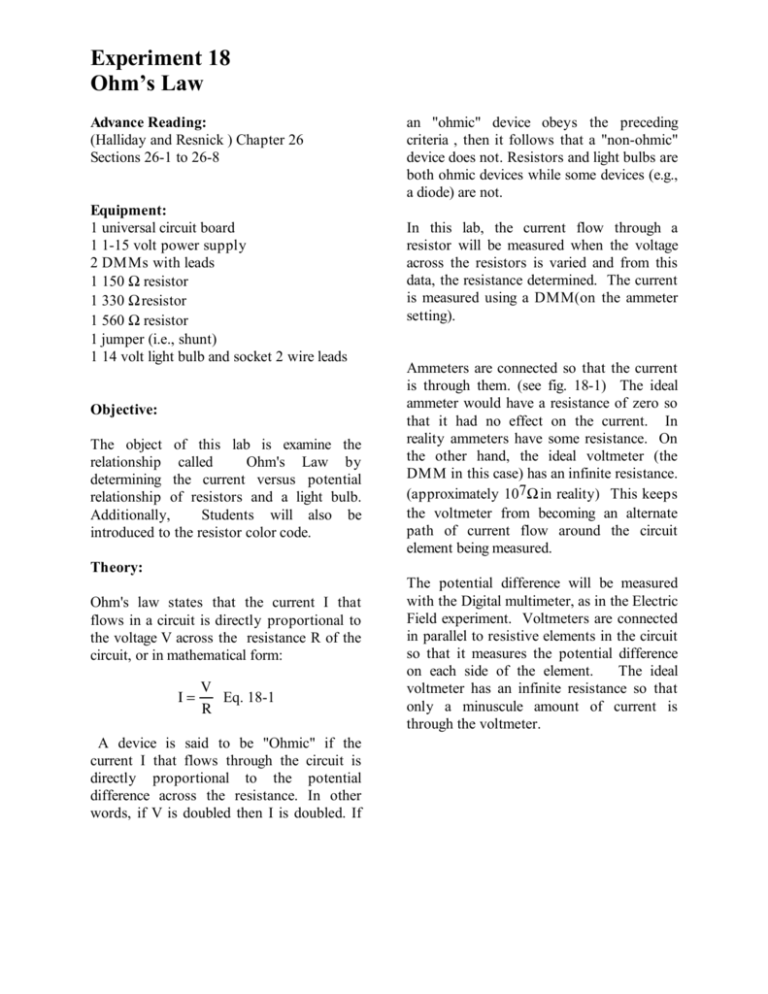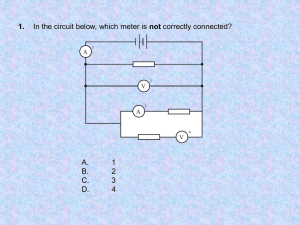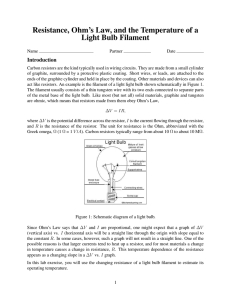Experiment 18 Ohm's Law
advertisement

Experiment 18 Ohm’s Law Advance Reading: (Halliday and Resnick ) Chapter 26 Sections 26-1 to 26-8 Equipment: 1 universal circuit board 1 1-15 volt power supply 2 DMMs with leads 1 150 resistor 1 330 resistor 1 560 resistor 1 jumper (i.e., shunt) 1 14 volt light bulb and socket 2 wire leads Objective: The object of this lab is examine the relationship called Ohm's Law by determining the current versus potential relationship of resistors and a light bulb. Additionally, Students will also be introduced to the resistor color code. an "ohmic" device obeys the preceding criteria , then it follows that a "non-ohmic" device does not. Resistors and light bulbs are both ohmic devices while some devices (e.g., a diode) are not. In this lab, the current flow through a resistor will be measured when the voltage across the resistors is varied and from this data, the resistance determined. The current is measured using a DMM(on the ammeter setting). Ammeters are connected so that the current is through them. (see fig. 18-1) The ideal ammeter would have a resistance of zero so that it had no effect on the current. In reality ammeters have some resistance. On the other hand, the ideal voltmeter (the DMM in this case) has an infinite resistance. (approximately 107 in reality) This keeps the voltmeter from becoming an alternate path of current flow around the circuit element being measured. Theory: Ohm's law states that the current I that flows in a circuit is directly proportional to the voltage V across the resistance R of the circuit, or in mathematical form: I= V Eq. 18-1 R A device is said to be "Ohmic" if the current I that flows through the circuit is directly proportional to the potential difference across the resistance. In other words, if V is doubled then I is doubled. If The potential difference will be measured with the Digital multimeter, as in the Electric Field experiment. Voltmeters are connected in parallel to resistive elements in the circuit so that it measures the potential difference on each side of the element. The ideal voltmeter has an infinite resistance so that only a minuscule amount of current is through the voltmeter. First Digit Supply Power R - 0-15v There is a color coding scheme used to identify the value of the resistance of a resistor. The first two color bands give the first two digits in the resistance value. The third band gives the multiplier for the first two in powers of ten. The last color is the tolerance. For example, a resistor that has two red bands and a black multiplier band, has a resistance of 22. The figures below give the color code. + Resistor Color Code A Multiplier figure 18-1 Procedure: Second Digit Tolerance figure 18-2 Color Black Brown Red Orange 3 Yellow Green Blue Violet Gray White Tolerance Gold Silver 10% no band Number Multiplier 0 100 1 101 2 102 103 4 104 5 105 6 106 7 107 8 108 9 109 5% 20% figure 18-3 1. Make a simple series circuit with the 150 (as shown in fig. 18-1), using the power supply, milliammeter (DMM), shunt, and wire leads. Have the circuit approved by your instructor before turning anything on. CAUTION: NEVER HOOK AN AMMETER IN PARALLEL WITH A POWER SUPPLY. IT HAS A RESISTANCE CLOSE TO ZERO AND COULD BE DAMAGED or a blow fuse. 2. Plug in the power supply and adjust the voltage until the DMM reads a one volt potential difference across the resistor. Using 2nd DMM measure the current . Set DMM on 200 milliamp setting. 3. Increase the voltage in one volt increments up to 12 volts, measuring the current through the resistor at each voltage level. Record all values of current I in amperes and voltage V in volts. V 4. Repeat this procedure for the 330 and 560 resistors. laptop, desktop and maker if you use your own computer. 5. Graph I vs. V and plot a best fit line for each of the resistors on the same graph. Calculate the slope of each line. From these slopes, obtain the value of the resistances R for the resistors. Be sure to label each of the slopes appropriately. 3. The power output of a circuit is given by V2 P = i 2R = = iV Eq. 18-2 R Calculate the power output of each resistive element when a potential of 12 volts is applied. 6. Measure the resistance of each resistor using the ohmmeter function of the DMM. Do this by placing the input wires in the correct holes on the DMM and turning the dial to the ohms () postion. The DM M provides a potential difference between the leads and measures the amount of current through the resistance. Be sure and write down color code values including tolerances. (see figure 18-2). 4. Verify dimensionally that equation 18-2 is correct. What are the units of power output? 7. Replace the resistors with the light bulb and repeat step 3 (except for light bulb use 0.2 volts increments until one volt and then one volt increments up to 12 volts). Plot a graph of I vs. V for the light bulb, only this time curve fit the data using a best fit curve. Questions/Conclusions: 1. Calculate the percent difference between the color code value and the experimental value found in this experiment for each resistor. Do these values fall within the bounds of the precision printed on the sides of the resistors? If they do not, what might be the reason for this? 2. Calculate the cost of running the light bulb you used in lab at 12 volts for one year. Go online or use an electric bill to determine the cost of a kilowatt-hour of electricity. Calculate the cost of a computer left on for one year. Give type of computer (i.e., 5. Is the graph of I vs. V for the light bulb linear? What type of curve fit did your light bulb have? What does this tell you about the resistance of a lightbulb as the filament gets hotter?











